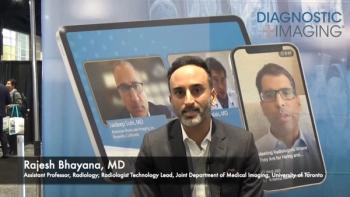
- Diagnostic Imaging Vol 31 No 2
- Volume 31
- Issue 2
Flat-panel detection speedsdiagnosis and throughput
Conventional radiography/fluoroscopyhas always been cumbersome.
Conventional radiography/fluoroscopy has always been cumbersome.
The equipment is big and bulky, and the examination is time-consuming, as technologists wrestle with cassettes between exposures and wait for film to develop.
The introduction of digital flatpanel detectors is not only streamlining the configuration of R/F rooms and simplifying throughput. It is also improving the detection of pathology, reducing radiation dose, and increasing patient comfort. It is assessing motion in real-time as well, so radiotherapy can be delivered in the highest tolerable dose to the most precisely defined tumor target.
Flat-panel detectors from major suppliers such as Varian and Trixell can be found in R/F systems by GE, Hitachi, Philips, Shimadzu, Siemens, and Toshiba.
One advantage of the digital flat panel is its large area. In contrast to image intensifiers, which have a maximum size of 16 inches, general-purpose flat-panel detectors are 14 x 17 or 17 x 17 inches. The larger coverage means fewer exposures and faster exam time.
“Doctors can catch live motion video, take exposures here and there, and do all of the spot filming they want on one exposure. Generally in the past, techs would have to step in and do a series of five or six exposures.
Imaging has gotten much faster because there is no cassette handling. Now the radiologist pushes a button, the exposure is made, and a few seconds later, the radiologist gets the image and can go on to the next. He or she doesn't have to switch between the radiography and fluoroscopy world,” said Tom Truesdell, manager of radiography/fluoroscopy for Siemens Medical Solutions. Speed means not only better throughput; it also improves lesion detection.
“The response time of a digital flatpanel R/F system is very fast. You are on rapid fire taking images. So you are more likely to capture the pathology you are seeking. You also know right away whether you have the image you want,” said Dr. Edward Lubat, managing partner of Radiology Associates of Ridgewood in Waldwick, NJ.
Unlike image intensifiers, which are not geometrically accurate and produce pincushion distortion at the edges, flat panels have uniform image quality from edge to edge. Flat-panel technology also has higher detective quantum efficiency (DQE) than image intensifier charge-coupled device camera systems, which translates into superior small area contrast resolution and improved visibility of small vessels and catheters, according to Dr. Rick Colbeth, vice president of flatpanel technology for Varian.
Flat-panel technology has greatly improved image quality on the fluoroscopy side. As a result, radiologists in Europe are finding that they can use lower-dose fluoroscopy and still capture diagnostic events without needing to switch to high-dose, highresolution radiography. Prof. Yvan Palmers, director of imaging services for Ziekenhuis Oost-Limburg in Ghent, Belgium, has acquired a diagnostic- quality image in the fluoroscopy mode that used 30% of the radiation dose required by the traditional radiography mode.
Flat panels are smaller and lighter than image intensifier CCD camera systems, so digital R/F systems tend to be more maneuverable. Added space beneath the system allows the table to be lowered to a 19-inch height for easy and more comfortable patient transfers. Reduced ancillary equipment and increased distance between the table and the imaging tower facilitate patient positioning. If it weren't for flat-panel technology, real-time gating during imageguided radiation therapy would be impossible, said Dr. Todd Scarbrough, medical director of Melbourne Internal Medical Associates Cancer Center in Melbourne, FL.
Now that a flat-panel device has been attached to a linear accelerator, Scarbrough can track the movement of a fiducial metallic marker on the surface of a tumor as it moves with the respiratory cycle in order to synchronize the release of a beam of radiation.
“We can't move the radiation beam around, but we can find out where the tumor is and turn the beam on or off depending on the respiratory cycle. It's important for us to be exceedingly accurate with how we delivery radiotherapy, and flat-panel imaging lets us do that. It allows us to decrease side effects and go to a higher dose because we are confident about where the radiation is going,” Scarbrough said.
Articles in this issue
almost 17 years ago
International experts, cutting-edgetechnology impress RSNA newbiealmost 17 years ago
Radiology gets sent off to the washhousealmost 17 years ago
Clinicians identify tacticsthat minimize risk of NSFalmost 17 years ago
Edgy NSF article may have gone too faralmost 17 years ago
Game changes with new portable and wireless digital radiographyalmost 17 years ago
Study confirms: Digitalmammo lengthens read timealmost 17 years ago
Vertebroplasty data hint atnegative effect on survivalalmost 17 years ago
Vampire bat thrombolytic study findings disappointalmost 17 years ago
Incidental finding on MRIpoints to multiple sclerosisalmost 17 years ago
3D neuro imaging techniquerealizes Orwellian visionNewsletter
Stay at the forefront of radiology with the Diagnostic Imaging newsletter, delivering the latest news, clinical insights, and imaging advancements for today’s radiologists.




























